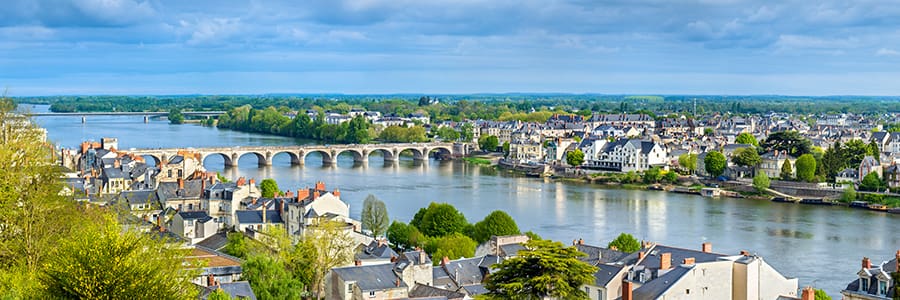
About The Loire River
The name “Loire” comes from Latin Liger, which is a transcription of the native Gaulish (Celtic) name of the river, liga, which means “silt, sediment, deposit, alluvium.”
Rising in the highlands of the southeastern quarter of the Massif Central in the Cevennes range of the Ardeche, the Loire is the longest river in France. At 629 miles in length, it drains an area of more than 45,000 square miles, more than a fifth of the country’s land area.
The Loire Valley, which lies in the middle stretch of the river and extends for about 170 miles, is known as the “Garden of France.” Studded with more than a thousand chateaux, each with distinct architectural embellishments ranging from early medieval to late Renaissance, the region also boasts an abundance of vineyards, fruit orchards, and farms which line the banks of the river, along with many historic villages. For all these riches, UNESCO added the central part of the Loire Valley to its list of World Heritage Sites.
To glide along the Loire in a state-of-the-art paddle-wheel river cruiser is to enjoy a taste of the good life artists and aristocrats have been enjoying for centuries. With so much to see, taste, and experience, the luxury of returning to your own floating hotel, to relax and let the marvels come to you, is truly the journey of a lifetime.
Loire River Stats
Length: 629 miles
Depth: 5 to 11 feet
Source: Massif Central, Southern France
Mouth: Bay of Biscay, Atlantic Ocean, France
Locks: None
Countries: France
Learn More About the Loire River of Europe
The Loire River, known as “La Loire” in French, is one of Europe’s most iconic and picturesque waterways, winding its way through the heartland of France. Stretching for approximately 1,012 kilometers (629 miles), it is the longest river in France and flows through some of the country’s most enchanting regions, making it a source of pride for the French people and a favorite destination for travelers from around the world.
Geography and Source
The Loire River originates in the Massif Central region of south-central France, near the village of Mont Gerbier-de-Jonc. This pristine source, a small spring, marks the beginning of a journey that will take the river through diverse landscapes and regions before it finally empties into the Atlantic Ocean near the city of Nantes.
The Loire Valley
As the Loire River meanders through France, it carves a path through the historic and culturally rich Loire Valley, often referred to as the “Garden of France.” This region is renowned for its lush vineyards, charming medieval towns, and stunning châteaux (castles). The Loire Valley is a UNESCO World Heritage Site and has been a significant center of French art, culture, and history for centuries.
Biodiversity and Natural Beauty
The Loire River basin is home to a diverse array of flora and fauna. Its fertile floodplains support a rich ecosystem that includes a variety of bird species, fish, and wetland plants. The river is particularly important for birdwatchers, as it serves as a habitat and migratory route for numerous species, including herons, kingfishers, and swans. In fact, several national and regional nature reserves along the Loire are dedicated to the preservation of its unique natural beauty.
Charming Towns and Cities
Throughout its course, the Loire River flows past picturesque towns and cities that have played important roles in French history and culture. Orleans, for example, is known for its connection to Joan of Arc, who helped liberate the city from English forces during the Hundred Years’ War. Tours is another notable city, famous for its medieval old town and the stunning Cathedral of Saint Gatien. Additionally, the Loire River passes through the vibrant city of Nantes, where it meets the Atlantic Ocean.
Châteaux of the Loire Valley
Perhaps one of the most iconic aspects of the Loire River and the surrounding region is the abundance of magnificent châteaux. These grand castles, often set amidst idyllic landscapes, are scattered along the riverbanks and its tributaries. Some of the most famous châteaux include Château de Chambord, Château de Chenonceau, and Château de Villandry, each known for its unique architectural style, history, and gardens. These architectural masterpieces attract visitors from around the globe, making the Loire Valley a dream destination for history and architecture enthusiasts.
Wine Country
The Loire Valley is renowned for its vineyards and wine production. The region is famous for producing a wide range of wines, including crisp Sauvignon Blancs, elegant Chenin Blancs, and sparkling Crémants. Touring the vineyards and wine cellars of the Loire Valley is a delightful experience for wine connoisseurs and those interested in French viticulture.
Cultural Significance
The Loire River and its surroundings have played a significant role in French culture and history. Writers, painters, and musicians have drawn inspiration from the river’s beauty and tranquility. Charles Perrault, the author of classic fairy tales like Cinderella and Sleeping Beauty, was born in the Loire Valley. Additionally, the river’s châteaux and landscapes have been featured in numerous works of art and literature.
Environmental Challenges and Conservation Efforts
Despite its natural beauty and cultural importance, the Loire River faces various environmental challenges, including pollution, habitat destruction, and water management issues. Efforts have been made to address these challenges through conservation initiatives and sustainable development practices. Local organizations and government agencies are working to protect the river’s biodiversity and ensure its long-term health.
Recreation and Tourism
The Loire River offers a wide range of recreational opportunities. From boating and kayaking to hiking and cycling along its scenic banks, there are countless ways to experience the river’s beauty. The Loire à Vélo, a well-known cycling route, allows travelers to explore the region at a leisurely pace while taking in its natural and cultural wonders.
